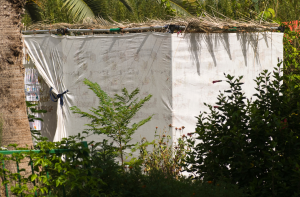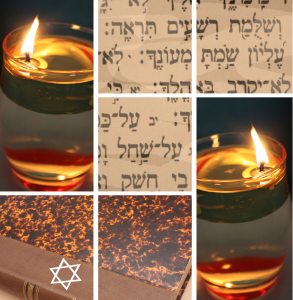We begin sitting in the sukkah on the first night of Sukkos, which begins this year on Friday night, September 29th. The mitzvah continues until the night of Shemini Atzeret, which falls this year on Friday night and Saturday, October 7th.
The main obligation is on the first two nights of Sukkot, but the mitzvah continues throughout the holiday, for the entire seven days. Besides the first two nights, the obligation is whenever we eat a meal during the week of Sukkos, and it is an additional mitzvah to sit there even when not eating an actual meal, like to talk with a friend, read a book, etc.
This mitzvah is learned from the verse that says “You shall dwell in booths (Sukkos) for seven days…” (Leviticus 23:42) The Talmud explains this means to live in the sukkah the way you would dwell in your own home for those seven days. (Talmud, Sukkah 26).
Many, climate permitting, sleep in the sukkah as well.
The minimum size of a sukkah is two walls attached together like an L, each being 28 inches wide, and a third wall which is about 4 inches wide, all being at least 40 inches tall. I would not recommend trying to get your family to eat a meal in a sukkah that size! There’s no maximum size, and many build Sukkos which are quite large to accommodate their families and company. Ideally, we build four complete walls to give the feeling of a home.
Keep in mind, however, that the covering on top, which consists of branches, leaves, bamboo or thin strips of wood, must overlay the sukkah in such a way that the majority of the ceiling is covered. This is in order that the sukkah will be shady. The larger the sukkah, the more branches you need. Specially made sukkah mats are available, which can be rolled out on top and cover a lot of area. (The covering should not be attached, just laid on top.)
There are many intricate questions as to the building of the sukkah, such as when it is permitted to use one or more of the walls of one’s house as walls of the sukkah. (Feel free to contact me via email and I’ll try to either answer you, or schedule a rabbi to see your sukkah if necessary, as some cases are difficult to visualize without being seen.)
The Torah says that when we sit in the sukkah, we are to remember that we sat in sukkos when we left the Land of Egypt. It teaches us that G-d is protecting us even when on the move. Sukkot is known as the “time of our joy.” This is because we realize we can be happy even when not surrounded by our usual creature comforts, and are existing in a simple hut, which we have “wandered” to from our homes. It is a celebration of simply being alive and being connected to G-d.
This has been an important lesson for our People for thousands of years that we have been the “wandering Jews,” from place to place and country to country. We never lost our faith or our joy. Those Jews teach us the lesson of the sukkah!
Wishing you and all a joyous Sukkos holiday!
Sincerely,
Rabbi Yerachmiel Fried


